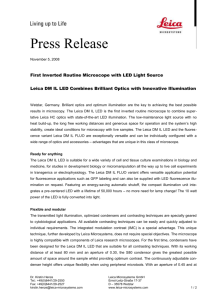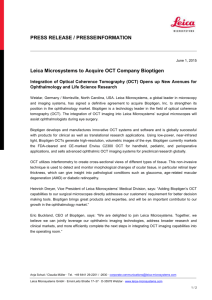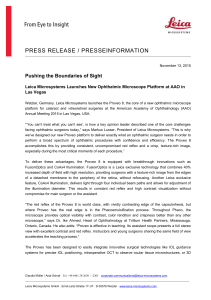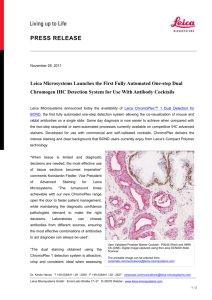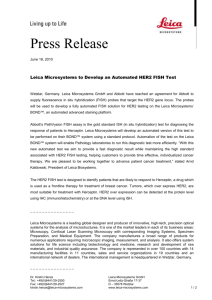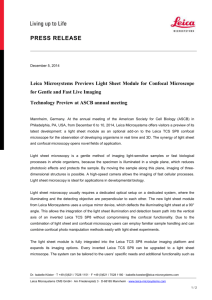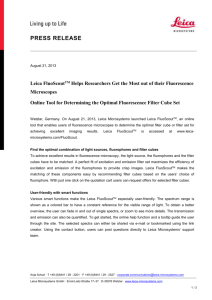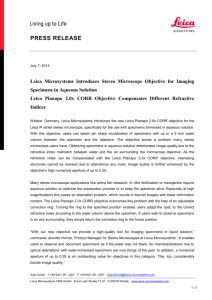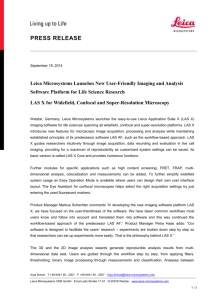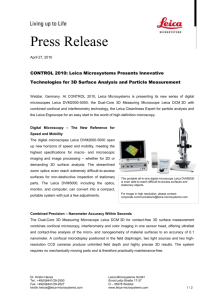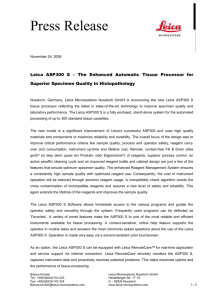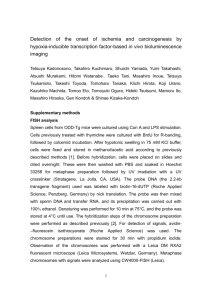Leica Microsystems Press Release
advertisement
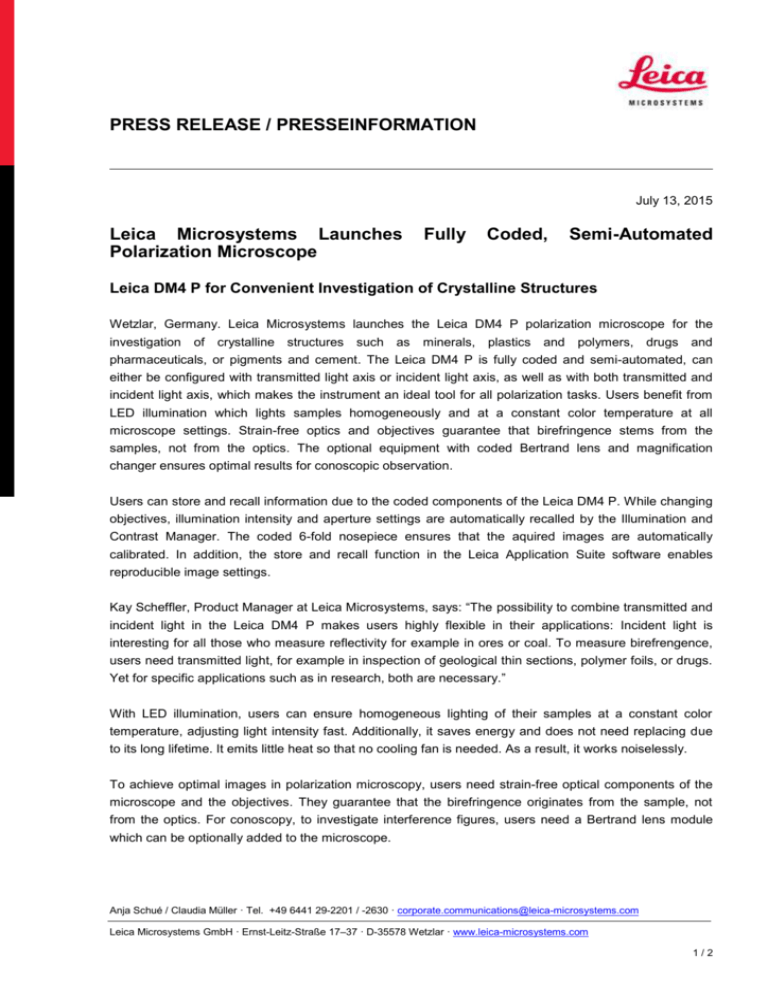
PRESS RELEASE / PRESSEINFORMATION July 13, 2015 Leica Microsystems Launches Polarization Microscope Fully Coded, Semi-Automated Leica DM4 P for Convenient Investigation of Crystalline Structures Wetzlar, Germany. Leica Microsystems launches the Leica DM4 P polarization microscope for the investigation of crystalline structures such as minerals, plastics and polymers, drugs and pharmaceuticals, or pigments and cement. The Leica DM4 P is fully coded and semi-automated, can either be configured with transmitted light axis or incident light axis, as well as with both transmitted and incident light axis, which makes the instrument an ideal tool for all polarization tasks. Users benefit from LED illumination which lights samples homogeneously and at a constant color temperature at all microscope settings. Strain-free optics and objectives guarantee that birefringence stems from the samples, not from the optics. The optional equipment with coded Bertrand lens and magnification changer ensures optimal results for conoscopic observation. Users can store and recall information due to the coded components of the Leica DM4 P. While changing objectives, illumination intensity and aperture settings are automatically recalled by the Illumination and Contrast Manager. The coded 6-fold nosepiece ensures that the aquired images are automatically calibrated. In addition, the store and recall function in the Leica Application Suite software enables reproducible image settings. Kay Scheffler, Product Manager at Leica Microsystems, says: “The possibility to combine transmitted and incident light in the Leica DM4 P makes users highly flexible in their applications: Incident light is interesting for all those who measure reflectivity for example in ores or coal. To measure birefrengence, users need transmitted light, for example in inspection of geological thin sections, polymer foils, or drugs. Yet for specific applications such as in research, both are necessary.” With LED illumination, users can ensure homogeneous lighting of their samples at a constant color temperature, adjusting light intensity fast. Additionally, it saves energy and does not need replacing due to its long lifetime. It emits little heat so that no cooling fan is needed. As a result, it works noiselessly. To achieve optimal images in polarization microscopy, users need strain-free optical components of the microscope and the objectives. They guarantee that the birefringence originates from the sample, not from the optics. For conoscopy, to investigate interference figures, users need a Bertrand lens module which can be optionally added to the microscope. Anja Schué / Claudia Müller · Tel. +49 6441 29-2201 / -2630 · corporate.communications@leica-microsystems.com Leica Microsystems GmbH · Ernst-Leitz-Straße 17–37 · D-35578 Wetzlar · www.leica-microsystems.com 1/2 PRESS RELEASE / PRESSEINFORMATION Caption: Leica Microsystems launches fully coded, semiautomated polarization microscope Leica DM4 P. For more information please visit http://www.leica-microsystems.com/products/light- microscopes/industrial-materials/polarization-microscopes/details/product/leica-dm4-p/ More information on polarization microscopy on Science Lab (http://www.leica- microsystems.com/science-lab/polarization-contrast/) Step-by-step polarization tutorial: http://www.leica-microsystems.com/science-lab/the-principles-of- polarization-contrast/ ___________________________________________ About Leica Microsystems Leica Microsystems develops and manufactures microscopes and scientific instruments for the analysis of microstructures and nanostructures. Ever since the company started as a family business in the nineteenth century, its instruments have been widely recognized for their optical precision and innovative technology. It is one of the market leaders in compound and stereo microscopy, digital microscopy, confocal laser scanning microscopy with related imaging systems, electron microscopy sample preparation, and surgical microscopes. Leica Microsystems has seven major plants and product development sites around the world. The company is represented in over 100 countries, has sales and service organizations in 20 countries, and an international network of distribution partners. Its headquarters are located in Wetzlar, Germany. Anja Schué / Claudia Müller · Tel. +49 6441 29-2201 / -2630 · corporate.communications@leica-microsystems.com Leica Microsystems GmbH · Ernst-Leitz-Straße 17–37 · D-35578 Wetzlar · www.leica-microsystems.com 2/2
